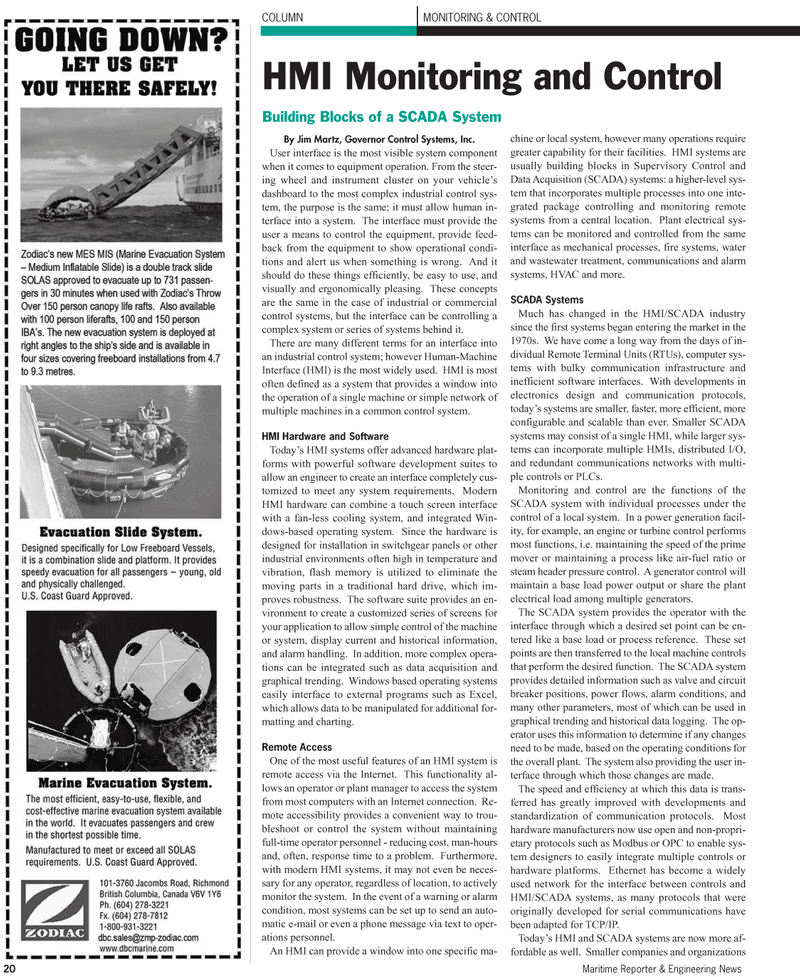
Page 20: of Maritime Reporter Magazine (February 2011)
Cruise & Passenger Vessel Annual
Read this page in Pdf, Flash or Html5 edition of February 2011 Maritime Reporter Magazine
20 Maritime Reporter & Engineering News
By Jim Martz, Governor Control Systems, Inc.
User interface is the most visible system component when it comes to equipment operation. From the steer- ing wheel and instrument cluster on your vehicle’s dashboard to the most complex industrial control sys- tem, the purpose is the same; it must allow human in- terface into a system. The interface must provide the user a means to control the equipment, provide feed- back from the equipment to show operational condi- tions and alert us when something is wrong. And it should do these things efficiently, be easy to use, and visually and ergonomically pleasing. These concepts are the same in the case of industrial or commercial control systems, but the interface can be controlling a complex system or series of systems behind it.
There are many different terms for an interface into an industrial control system; however Human-Machine
Interface (HMI) is the most widely used. HMI is most often defined as a system that provides a window into the operation of a single machine or simple network of multiple machines in a common control system.
HMI Hardware and Software
Today’s HMI systems offer advanced hardware plat- forms with powerful software development suites to allow an engineer to create an interface completely cus- tomized to meet any system requirements. Modern
HMI hardware can combine a touch screen interface with a fan-less cooling system, and integrated Win- dows-based operating system. Since the hardware is designed for installation in switchgear panels or other industrial environments often high in temperature and vibration, flash memory is utilized to eliminate the moving parts in a traditional hard drive, which im- proves robustness. The software suite provides an en- vironment to create a customized series of screens for your application to allow simple control of the machine or system, display current and historical information, and alarm handling. In addition, more complex opera- tions can be integrated such as data acquisition and graphical trending. Windows based operating systems easily interface to external programs such as Excel, which allows data to be manipulated for additional for- matting and charting.
Remote Access
One of the most useful features of an HMI system is remote access via the Internet. This functionality al- lows an operator or plant manager to access the system from most computers with an Internet connection. Re- mote accessibility provides a convenient way to trou- bleshoot or control the system without maintaining full-time operator personnel - reducing cost, man-hours and, often, response time to a problem. Furthermore, with modern HMI systems, it may not even be neces- sary for any operator, regardless of location, to actively monitor the system. In the event of a warning or alarm condition, most systems can be set up to send an auto- matic e-mail or even a phone message via text to oper- ations personnel.
An HMI can provide a window into one specific ma- chine or local system, however many operations require greater capability for their facilities. HMI systems are usually building blocks in Supervisory Control and
Data Acquisition (SCADA) systems: a higher-level sys- tem that incorporates multiple processes into one inte- grated package controlling and monitoring remote systems from a central location. Plant electrical sys- tems can be monitored and controlled from the same interface as mechanical processes, fire systems, water and wastewater treatment, communications and alarm systems, HVAC and more.
SCADA Systems
Much has changed in the HMI/SCADA industry since the first systems began entering the market in the 1970s. We have come a long way from the days of in- dividual Remote Terminal Units (RTUs), computer sys- tems with bulky communication infrastructure and inefficient software interfaces. With developments in electronics design and communication protocols, today’s systems are smaller, faster, more efficient, more configurable and scalable than ever. Smaller SCADA systems may consist of a single HMI, while larger sys- tems can incorporate multiple HMIs, distributed I/O, and redundant communications networks with multi- ple controls or PLCs.
Monitoring and control are the functions of the
SCADA system with individual processes under the control of a local system. In a power generation facil- ity, for example, an engine or turbine control performs most functions, i.e. maintaining the speed of the prime mover or maintaining a process like air-fuel ratio or steam header pressure control. A generator control will maintain a base load power output or share the plant electrical load among multiple generators.
The SCADA system provides the operator with the interface through which a desired set point can be en- tered like a base load or process reference. These set points are then transferred to the local machine controls that perform the desired function. The SCADA system provides detailed information such as valve and circuit breaker positions, power flows, alarm conditions, and many other parameters, most of which can be used in graphical trending and historical data logging. The op- erator uses this information to determine if any changes need to be made, based on the operating conditions for the overall plant. The system also providing the user in- terface through which those changes are made.
The speed and efficiency at which this data is trans- ferred has greatly improved with developments and standardization of communication protocols. Most hardware manufacturers now use open and non-propri- etary protocols such as Modbus or OPC to enable sys- tem designers to easily integrate multiple controls or hardware platforms. Ethernet has become a widely used network for the interface between controls and
HMI/SCADA systems, as many protocols that were originally developed for serial communications have been adapted for TCP/IP.
Today’s HMI and SCADA systems are now more af- fordable as well. Smaller companies and organizations
COLUMN
HMI Monitoring and Control
Building Blocks of a SCADA System
MONITORING & CONTROL

 19
19

 21
21
